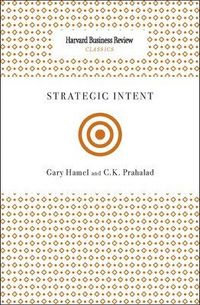
endast ny
Strategic Intent
In this McKinsey Award-winning article, first published in May 1989, Gary Hamel and C.K. Prahalad explain that Western companies have wasted too much time and energy replicating the cost and quality advantages their global competitors already experience. Canon and other world-class competitors have taken a different approach to strategy: one of strategic intent.
They begin with a goal that exceeds the company's present grasp and existing resources: "Beat Xerox"; "encircle Caterpillar." Then they rally the organization to close the gap by setting challenges that focus employees' efforts in the near to medium term: "Build a personal copier to sell for $1,000"; "cut product development timeby 75%."
Year after year, they emphasize competitive innovation building a portfolio of competitive advantages; searching markets for "loosebricks" that rivals have left under defended; changing the terms of competitive engagement to avoid playing by the leader's rules. The result is a global leadership position and an approach to competition that has reduced larger, stronger Western rivals to playing an endless game of catch-up.
Utgiven: 2010
ISBN: 9781422136546
Förlag: Harvard Business School Press
Format: Häftad
Språk: Engelska
Sidor: 112 st
In this McKinsey Award-winning article, first published in May 1989, Gary Hamel and C.K. Prahalad explain that Western companies have wasted too much time and energy replicating the cost and quality advantages their global competitors already experience. Canon and other world-class competitors have taken a different approach to strategy: one of strategic intent.
They begin with a goal that exceeds the company's present grasp and existing resources: "Beat Xerox"; "encircle Caterpillar." Then they rally the organization to close the gap by setting challenges that focus employees' efforts in the near to medium term: "Build a personal copier to sell for $1,000"; "cut product development timeby 75%."
Year after year, they emphasize competitive innovation building a portfolio of competitive advantages; searching markets for "loosebricks" that rivals have left under defended; changing the terms of competitive engagement to avoid playing by the leader's rules. The result is a global leadership position and an approach to competition that has reduced larger, stronger Western rivals to playing an endless game of catch-up.
Ny bok
144 kr151 kr
5% studentrabatt med Studentapan
Begagnad bok (0 st)
Varje vecka tillkommer tusentals nya säljare. Bevaka boken så får du meddelande när den finns tillgänglig igen.



